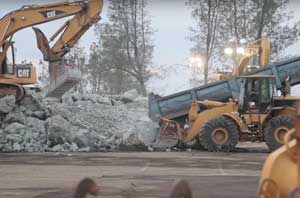As I was traveling from rebellious Kiev to Eastern Ukraine with pastor Gennadiy Mokhnenko, President Poroshenko was forced to block all communications between Ukraine and the breakaway territories of Donetsk and Luhansk. Car and train traffic between the adversaries has virtually stopped. To reach the frontline town of Mariupol, I had to take a route along the Dnieper River, which crosses the country from South Ukraine to the Black Sea. In Melitopol, which used to be the gateway to Crimea before the war, we disembark the train and get in a car to travel toward the frontline.
The same day the media reported another massive shootout between the Ukrainian military and the pro-Kremlin militia; 8 people were killed and more than 10 wounded. It was rumored a group of saboteurs were moving toward Mariupol to deflect the Ukrainians’ attention from the military warehouses in Kharkov; these were exploded the next day. Some said the Russian terrorists were disposing of Ukrainian munitions there, while others believed the Security Service of Ukraine was destroying the evidence of the weapons trade between Poroshenko’s supporters and the enemy. Another opinion was that all the weapons were actually shipped to Donetsk, and the empty warehouses set on fire.
The siege of Mariupol
Mariupol met us with numerous checkpoints where our IDs were thoroughly examined. A system of regularly changed passwords was used to let people pass into the military zone. The residents are immensely tired of the endless war that has been going on for more than 3 years.
Drivers in Mariupol do not wear seat belts – not because of the old Soviet habit, but to be able to quickly jump out of the car in case of the artillery fire. An artillery shell instantly rips a car apart like a tin can – the numerous rusty remains on the side of the road serve as a proof. The thin metal is unable to protect the passengers from the gunfire, and the car turns into a burning coffin on wheels.
[rev_slider front-ua]
The Motherland calls
On my way to the frontline, I visit one of the wrecked school buildings in the town of Shirokino. The former school complex is now totally destroyed.
Making short runs to avoid the sniper fire, we enter one of the buildings. Once we get there, we hear tank shells exploding somewhere close by. My guides tell me we got lucky because there were fewer than usual shots fired today. I had to concur.
In the dark and littered hallways, I step on glass shards and spent cases. Used missile launcher cartridges lay here and there. The school diner is shattered into pieces.
The classrooms where children’s voices could be heard just a few years ago are now empty and disorderly. Cold wind rushes in through the broken windowpanes, slapping me in the face and rustling the pages of abandoned textbooks and notebooks. The students and the teachers who ran away from the horrors of the war in 2014 left all their possessions here in the school complex. The bust of some Soviet leader with his nose broken off mournfully overlooks the devastation. The piano is torn into pieces by an artillery shell. The mural depicting Prince Vladimir and his men is ridden with bullets. Three years ago the town saw a fierce battle in which Ukrainian forces took this part of the Donetsk region back from the rebels.
The high school has lost its entire roof structure; heavy concrete slabs are overhanging the basketball court. Carefully watching our steps, we cross another hallway and see an unexploded artillery shell poking out from the ceiling. My guides explain the shell pierced the roof and got stuck in the slab. It could explode at any moment.
On the second floor we visit the Great Patriotic War museum room. Gennadiy Mokhnenko, a pastor and a chaplain from Mariupol, stands beside a large poster with a Soviet soldier on it. He says that it is very hard for him to see how Russia, the successor of the USSR, is destroying his land.
On the front lines
The famous Azov Sea resort area near Mariupol is ruined. The town of Shirokino is completely destroyed. Luxury homes are leveled, five-star hotels turned into rubble. Only the Russian Orthodox Church building remains intact.

VIDEO: What Is Happening at the Oroville Dam
One of the field encampments of the Ukrainians is situated in the former hotel complex that was virtually destroyed by enemy fire. We are standing among the huge piles of rubbish – the result of massive artillery fire from both sides. One of the balconies fell two stories from its original place. On another balcony is a life-size doll dressed in a vyshyvanka shirt – either as a joke, or as a decoy for the snipers.
The resort area is littered with broken concrete, pieces of wood, bricks and shell fragments. Ukrainian soldiers do not have to chop wood – whenever they need any fuel to stay warm, they just collect the tree branches severed by the gunfire.
The resort complex is just 50 meters away from the Azov Sea, but no one has been swimming here for the past three years; the beach is barricaded and the sea bottom is mined.
The Ukrainian line of defense is prepared for a surprise attack from the sea.
We stand amidst a squad of Ukrainian Army regulars who defend the front line. Most of them are young men who came here from all over the country. The conversations are both in Ukrainian and Russian. The soldiers buy their equipment and uniforms at their own expense. One of them is wearing a T-shirt with a large yellow trident, the coat-of-arms of Ukraine.



